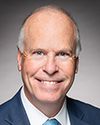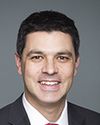Good morning, everyone.
Thank you so much for having me here today. It is an honour for me to address you.
I am Laura Boivin, president and co‑shareholder of Fumoir Grizzly for 12 years now. Fumoir Grizzly is a small business located in the province of Quebec. We currently have 95 employees and we produce several species of salmon as well as tuna, mostly smoked salmon and tartars that are distributed to most retailers and to restaurants, hotels and institutions.
We process five species of fish, including wild sockeye salmon, wild chum salmon, coho salmon, Atlantic salmon, farmed trout and tuna.
Today, I would like to highlight a few important things about Fumoir Grizzly as a fish processing company. I don't necessarily have an array of recommendations for you, but I will instead have some requests for you to consider.
First, what is confusing for the consumer is where the fish comes from. On the packaging of imported products, the origin related to the processing, farming or catching of the fish will be indicated. This is not clear and there is a lot of confusion. I myself have seen several labels on grocery shop packages that didn't have the right information on them, which means that the end consumer was misinformed.
Some labels on packages also contain claims that cannot be verified or are not verifiable. So you can say just about anything. I'm just thinking of the words “no antibiotics” or “with antibiotics” that are sometimes found on the packaging. At what stage in the company's value chain were antibiotics used or not used? There are no clear rules on this, and in my opinion, the rules can be confusing to the end consumer.
Then there is also the naming of the fish itself. In our industry, we have Atlantic salmon. There have already been advertising campaigns to inform the end consumer, but the name Atlantic salmon is not linked to its provenance, but rather to the different genetics that is specific to the Salmo salar species. It may come from British Columbia, Chile or Norway. The end consumer is not aware of this.
As for genetics, there can also be confusion regarding Pacific salmon, as a farmed salmon could have grown up in the Pacific Ocean in Chile. A wild salmon may be sockeye, king or chum. The packaging may simply state that it is wild Pacific salmon, when it could just as easily be a fish that is found in abundance in the ocean as a rare fish, with very different prices.
I would like to address the issue of transgenic salmon. I don't know if members of the committee have heard of it. We became aware of this salmon a few years ago. There was a lot of outrage from grocery shop chains that refused to sell it. The situation with transgenic salmon is unique in Canada in that there is no requirement to label it as transgenic salmon on the package, whether in restaurants, at the counter in fish shops, or wherever it will be consumed. The end consumer therefore does not know whether they are consuming transgenic salmon or not.
That being said, there are no health problems associated with transgenic salmon. I don't have a formal position on that, other than to say that it's not mentioned and that it should be addressed, in a context where we want to place importance on the traceability of fish.
In general, I will end by telling you that there are many standards that fish suppliers and processors must meet in terms of traceability. Fumoir Grizzly follows Hazard Analysis Critical Control Point, or HACCP, standards, and is also certified by the Safe Quality Food, or SQF, program and the Aquaculture Stewardship Council, or ASC. In addition, our suppliers are certified by the Marine Stewardship Council, or MSC, and by the Best Aquaculture Practices, or BAP, program. There are many rules related to traceability, and this requires integrated systems in the processing plants.
My only comment this morning is that we shouldn't add to the processing costs, which are already very high. Adding rules as to traceability, given the certification systems that are already in place, would probably add costs and not prevent us from needing those certifications.
Fumoir Grizzly submitted an application for ASC certification last week related to traceability. It has been audited and the only thing we had to change in our process was the position of the logo on our supplier's boxes. Certification with this organization will mean additional costs of 0.05% of sales volume. At the end of the day, it was found that traceability was well assured at Fumoir Grizzly.
It should be taken into account that certification bodies already exist, and we are joining them as a processing company. We need to avoid additional costs, and most importantly, we need to ensure that our existing regulations and certifications are applied to all products, including those exported to Canada.
Thank you for your attention. I would be happy to answer any questions you may have.




